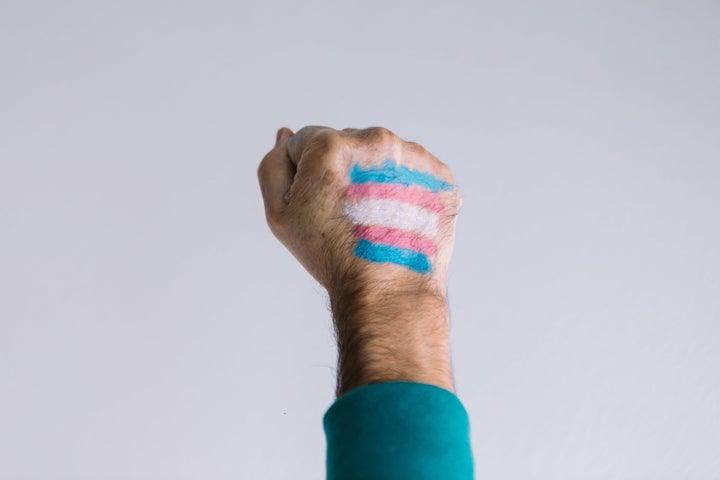
For Daphne Jansen, a 38-year-old trans woman from Colorado, the pandemic and life in lockdown had one silver lining: It was an ideal time to come out.
“It was actually the perfect time,” Jansen told HuffPost. “I wanted nothing more than to hide, or at least be very selective about who saw me and when.”
It took Jansen over a year to come out fully. She came out to her therapist in January 2020, to her partner at the time in March, to her daughter in April, to her family in June, publicly to her friends in September and finally at work in April 2021.
Prior to COVID-19, Jansen said she held back in claiming her gender for years because she “was ashamed about my feelings and had often held transition as a last resort before giving up on life.”
Lockdown gave her time to really reflect on whether that was true, or if she was denying some essential part of herself. The welcoming trans community on Twitter gave her a sense of belonging.
“There were so many people spending time online that I was finally able to talk to other trans people about their experiences for the first time, and it was deeply affirming even though I was an emotional wreck,” she said. “It’s not like every day is easy, but I feel present in my life in a way that I hadn’t before.”
Jansen isn’t alone in finding lockdown a welcoming place to come out, said Kevin Nadal, a professor of psychology at the City University of New York Graduate Center who researches the effects of microaggressions on racial minorities and LGBTQ+ people.
“The earlier part of the pandemic, where people were forced to shelter in place, stop their everyday routines, and for some, even witness people they love get sick or die, gave most people the opportunity to reflect and reevaluate what was important to them in life,” he said.
For some people who may have been grappling with their gender identity or sexual orientation for a long time, “the pandemic may have made them realize that they no longer wanted to live in a way in which they couldn’t be their truest or most authentic selves,” Nadal said.
Of course, this isn’t to say that coming out during a pandemic is easy. Even in non-pandemic times, trans people experience higher rates of depression and anxiety, economic insecurity, and social isolation. Since the onset of COVID, lockdown, housing insecurity (especially for trans youth and BIPOC trans people) and job losses have hit the trans community particularly hard.
As the Trevor Project reports, the coronavirus has shrunk LGBTQ+ youth’s safe spaces, with many young people confined to unsupportive home environments. For many people seeking out gender-affirming health care, medical procedures have had to be postponed.
Meanwhile, violent crimes against transgender and gender-nonconforming people surged in 2021, and there’s been a wave of anti-trans legislation pushed forth in state legislatures across the country.
“People who are coming out are grappling with this intense assault on their identities,” said Melanie Willingham-Jaggers, the interim executive director of GLSEN, an education organization working to create safe and inclusive schools for LGBTQ+ youth.
“Even for people who don’t live in states that are implementing these kinds of cruel bans, there’s a widespread effect on the social climate as anti-transgender extremists feel emboldened to follow politicians’ example and harass and discriminate,” Willingham-Jaggers said.
But in spite of these setbacks, plenty of people who were eager to transition pushed ahead.
Prior to the pandemic, it would have been rare to hear someone say it was a Zoom conference call that made them realize they were trans or nonbinary.
But that was at least partially the case for David, a 36-year-old trans man in Finland whose “egg cracked” in the midst of the pandemic. (As many trans people use the term, the “crack” is the nudging realization you might be transgender.)
Before lockdown, David ― who, like many in this story, asked to be identified by his first name only for the sake of privacy ― struggled to embrace the reality of “needing to be a man physically and mentally.”
But a number of experiences unique to the pandemic made him realize that presenting himself as a woman was never going to be sustainable.
Part of it, he says, was “Zoom dysphoria” from so much video conferencing.
“Seeing yourself on a video call day in and day out, and at worst having to hear back what you sound like, definitely made me realize how much I needed that physical transition to feel comfortable in my skin,” he said.
Of course, it wasn’t just Zoom that compelled him to get started on transitioning and hormone therapy.
“I wasn’t particularly worried about COVID, but the question ‘If I died today, would I be happy with how I lived my life?’ had such a glaringly obvious answer in the end that I had to move ahead with transitioning,” David said.
Transitioning during the pandemic had one big advantage, too: No one was watching or offering their commentary.
As David found, if you’re working from home and social distancing, you can transition without having to worry about the “cis gaze” ― for example, people asking prying questions, like why you look or sound differently lately. (As the trans writer Galen Mitchell described in a Medium essay, the “cis gaze” ― a play on the feminist concept of the male gaze ― refers to “the ways in which the world and trans people are presented in such a way as to make them appear as if they exist for scrutiny by, and the entertainment of, cis people.”)
In the workplace, at least, David’s co-workers have been incredibly supportive about him transitioning.
“They’ve been absolute champs,” he told HuffPost in an email. “They rarely, if ever, slip on my pronouns even though I don’t yet physically pass. (That voice drop could happen any day now, thanks!)”
Collette, a 37-year-old trans woman from San Diego, had a similar experience with remote work enabling her to come into her own gender identity.
“I wasn’t seeing anyone from the office. I wasn’t wasting energy posturing,” Collette, who works as an environmental consultant, told HuffPost.
“Before the pandemic, I traveled a lot for work, and the toxic personalities I’d meet traveling were gone,” she explained. “I was able to shave my beard ― something I’d wanted to do for a long time but was part of my then-identity.”

At some point, Collette thought: “Maybe this is possible after all.” (It helped that she has a wife who remains supportive even as Collette’s transition has brought complications to their marriage.)
Collette hasn’t come out to the majority of her co-workers, but most of the office is still working from home and most interactions are audio calls, so she’s not worried about colleagues commenting on her hair or newly feminine mannerisms.
“The few times I’ve seen co-workers, they’ve been shocked at how different I look and comment that I look younger or comment on my weight loss and how much my hair has grown, but they are otherwise clueless,” she said.
She’s started hormone replacement therapy and said she’s hopeful that in her next job, “I can enter the office and be known as Collette from day one.”
It’s not just adults who are coming out. Kids and teens are, too, Nadal said.
“During the pandemic, I can count at least six friends or family members in my life who had informed me that their adolescent child had disclosed to them their trans or queer identities,” he said. “The youngest was 11 years old and the oldest was 19 years old.”
Pfeiffer, a 14-year-old from Massachusetts, is one of them. Pfeiffer thought they were straight and cis before the pandemic, but they now identify as nonbinary and biromantic.
“With biromantic, which I found out first, I was looking at different people and I had the thought, ‘Hey, would you date boys or girls?’” Pfeiffer said. “And my thought was, ‘Do I have to decide?’ The answer was ‘no.’”
Pfeiffer says they used to wear androgynous clothes to school and avoid the color pink, but with a busy schedule of classes, sports and hanging out with friends, there was never much time to dive deeper into why that might be their preference.
The pandemic changed that. Pfeiffer had a lot of time to think ― “to sit there and be like, ‘OK, brain, what do you have for me?’” they said.
That’s how they realized their early fashion choices were suggestive of so much more: “That was me trying to explain to myself that I wasn’t cis.”
“Now I feel better about the way that I express myself,” Pfeiffer said. “I’ve cut my hair, found different clothing and different ways to verbally express myself as well ― pronouns and a name change, for instance.”
It helps to have the wholehearted support of their family. At school, where Pfeiffer is out with their classmates, a handful of students have reached out seeking support as they explore their own identities.
“I’m glad to be the first one to come out to my class and say, ‘Hey, it’s OK to do this,’” they said.
“I was very frustrated, once I had admitted to myself that I was trans, because I wanted to move at 100 mph but was unable to because everywhere was shut down.”
- Rachel, a 48-year-old newly identifying trans woman from Kent, England
Still, for many people, coming out to family and feeling secure as a trans person in public remains an uphill battle.
The stillness of lockdown made it easier for Lara, a 33-year-old from Canada, to finally come out and identify as transfemme nonbinary.
In early 2021, Lara started exploring her gender more, trying on feminine clothes to see how it looked and felt to move around the world as a woman.
It’s been a whirlwind process since then. She’s been wearing dresses every day to work, and she’s changed her name. She started seeking HRT in July, but COVID restrictions have stymied her quest to obtain it.
“For instance, my follow-up appointment was indefinitely delayed because of my city moving back into a lockdown state due to delta outbreaks,” she said. “So, it’s been five months since I started seeking HRT and I’m still waiting, mostly because of the pandemic.”
Gender dysphoria doesn’t really “go back into the box” once you start to feel it, Lara said, so for her, the past five months have been a period of worsening mental health.
“I’ve run out of things I can do to socially transition,” she said. “I feel stalled, and that makes every day harder than the last. I know who I am, but I can’t take any more concrete steps to become her, and that sucks.”
It’s a problem that Rachel, a 48-year-old newly identifying trans woman from Kent, England, can relate to. While there’s no shortage of Twitter threads full of people celebrating having come out as trans during the pandemic, finding a welcoming place to come out in person can be almost impossible.
“I was very frustrated, once I had admitted to myself that I was trans, because I wanted to move at 100 mph but was unable to because everywhere was shut down,” Rachel said.
At the height of the lockdown, she would have loved to go shopping for clothes, to get her eyebrows done and her ears pierced.
On a deeper level, as she worked through her feelings about coming out, Rachel says she felt an intense need to meet other trans people and connect, to see if they felt the same as her.

“I needed to meet my tribe, but all the support groups stopped before I could attend one,” she said. “In some ways, I couldn’t have timed it any worse, really.”
Still, in hindsight, all these delays were probably for the best. Rachel is married to a woman who, understandably, needed time to process the change.
“Everything being locked down made me slow down,” Rachel said. “My wife didn’t handle my coming out very well, and I think if I had been able to go out and do the things I wanted to do, it would have been way too fast for her to deal with.”
Even so, the couple is on unsure footing. They live in the same house but sleep in separate rooms. They’re officially separated, but are still friends and co-parents.
“It’s complicated,” Rachel said. “What was an opportunity for me to find myself was hell for her. She had to spend weeks in the house watching her husband slowly disappear and become a woman.”
For other trans people, coming out to parents who weren’t inside their pandemic bubble proved equally challenging.
Taylor Dolniak, a 25-year-old trans man, moved to California in September 2019, just in time for the world to shut down and isolate him from his parents, who lived in Pennsylvania.
“I had been grappling with coming out to them for a long time, because I figured if I did, I could finally start hormones and get on with my life,” he said. “But I had planned to tell them in person. That was no longer possible.”
As it was, he ended up coming out to them via a “very dramatic and poetic” Facebook message (“Thanks, anxiety,” Dolniak joked), and the process turned out to be protracted and very hard.
“They didn’t take to the news very well, and it was one of the hardest and darkest times of my life,” he said. “It was clear that we were going to need lots of time and communication before that relationship was healed. Thankfully, the pandemic gave us that.”
And because of lockdown, Dolniak had the space and time to work through his own heavy emotions and start hormones.
“Also, thankfully for the pandemic ― not something you hear a lot ― starting hormones in quarantine means that you get all the awkward puberty bits out of the way in private!” he said.

Dolniak was also in the middle of a job search while transitioning. (The last place he worked was fairly conservative. One co-worker told him they were “too old to understand the pronoun thing” and just referred to him as they perceived him, with feminine pronouns.)
There were two factors that made Dolniak’s job search particularly difficult.
“I was very afraid of being misgendered, and of having to explain my pronouns and out myself to possible employers for fear of them rejecting me because of that,” he said.
Eventually, though, Dolniak ended up being hired in his dream position at his dream company.
“They have been more accepting than I could ever imagine, and I am surrounded by countless other LGBTQ+ folks that share the same mindset and values as I do,” he said.
Still, Dolniak knows that as “a white, often cis-passing, trans man who has safe housing, a full-time job, and access to health care,” he’s had a privileged and relatively easy coming-out process.
Not everyone has such safety and security. LGBTQ+ people of color ― Black trans women in particular ― face much more harassment and less security than their white peers when coming out. And some newly unemployed trans youth who have had to move back home may not have a welcoming family environment to return to.
Even in the best of situations, the recent increase in transphobia in the U.S. has been an unsettling trend to follow, said Willingham-Jaggers, the GLSEN executive director. For people considering coming out, especially young people, the most important thing to remember is that safety comes first, she said.
“It’s completely fine to be out in some spaces and not others, and you don’t need to come out publicly to be valid in your identity,” she said.
Lara, the Canadian hoping to start HRT, understands that apprehension. Her excitement about coming out is tempered by her fears of going out in public. Proclaiming you’re out on Twitter, sometimes anonymously, is one thing; walking into the public bathroom space that best aligns with your gender identity is another.
“I am acutely aware of the constant daily stream of transphobia in the media and the world,” she said. “I spend every day a little bit afraid for myself. I can’t walk out my front door without being worried that today might be the day someone decides to harass me on the street, or worse.”
The reality is that the world is a particularly unfriendly place to trans people right now. But Lara can’t imagine ever having to go back to her life before the pandemic.
“Thirty years is a long time to live in a state of mild dissociation,” she said. “Not living that way anymore is like finally breathing air after a life of being underwater.”